This post may contain affiliate links. Please read our disclosure policy. As an Amazon Associate, I earn from qualifying purchases.
This is an easy sourdough bread recipe using your natural sourdough starter. This can be baked in a dutch oven or on a sheet pan for equally great results.
The smell of this bread baking will fill your house and give you warm, cozy feelings. Serve it with some good butter or a dipping sauce like garlic butter sauce or herbed olive oil.
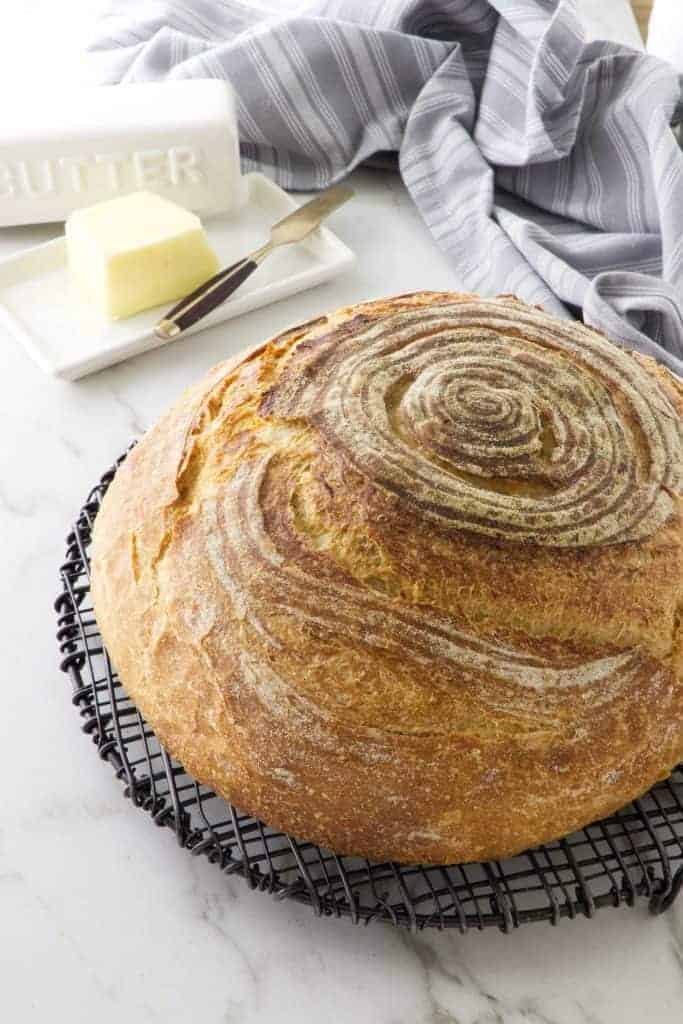
Sourdough bread recipes tend to look intimidating and complicated. If you look at most sourdough bread recipes, they are long and have several steps to them. Additionally, for anyone that is new to baking sourdough, most recipes use unfamiliar terminology.
Truly, you don’t need to know the difference between a poolish, levain, mother, or sponge to make great sourdough bread. And you don’t need to take all the extra steps to be successful.
How to make this easy sourdough bread recipe:
A condensed version of all the steps can be broken down into five basic actions.
- Mix all the ingredients together and knead the dough.
- Let the dough rise.
- Shape the dough.
- Let the dough rise a second time.
- Bake the loaf of bread.
It is really that easy. The instructions in the recipe card are lengthier in order to give you more success but all you have to do is start. The more you bake bread, the more proficient you will get. You will even find yourself checking out long, complicated recipes. Bread making is an addicting hobby.
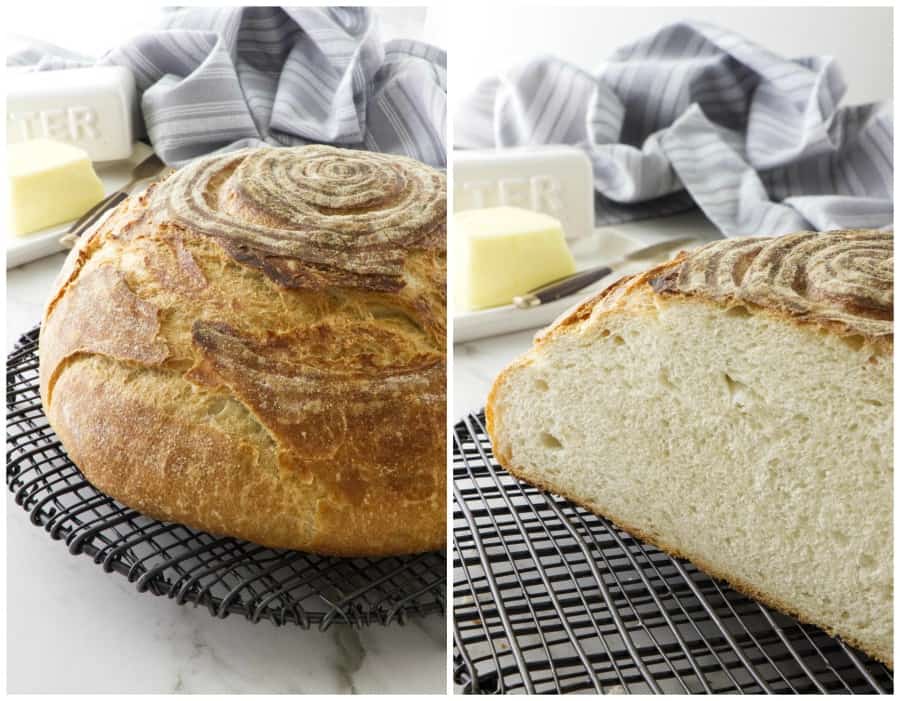
Do you need to knead the dough
Kneading dough helps form the gluten and gives the bread strength, structure, and better texture. With most bread recipes, in order to get the gluten to develop completely, you will have to knead the dough for 10 minutes or longer. However, another way that gluten is formed is to allow the enzymes in the flour to break down the proteins and develop the gluten. In other words, letting the dough sit for an extended period of time will naturally “knead” the bread.
Since natural wild yeast works slower than commercial yeast, the longer ferment time will do most of the kneading for you. As a result, this recipe does not require a long knead time. If you find it therapeutic then go ahead and knead the dough. But if you’re anxious to move on to your next chore then you only need to work the dough for a minute.
Is it necessary for the bread to rise twice?
Almost every yeast bread recipe instructs you to let the bread go through two rise sessions. Mix it, knead it and let it rise once. Then knock the air out, shape the loaf and let it rise a second time. If you’re new to bread making, you may want to skip that second rise and bake it right after the first rise.
If you really want to skip the second rise, you can. You will still have a reasonably decent loaf of bread. However, if you want exceptional sourdough bread, then yes, allow the bread to rise a second time. The second rise does all kinds of magic to the bread. It gives it a much nicer texture and allows more flavors to develop, giving it a rich and malty flavor.
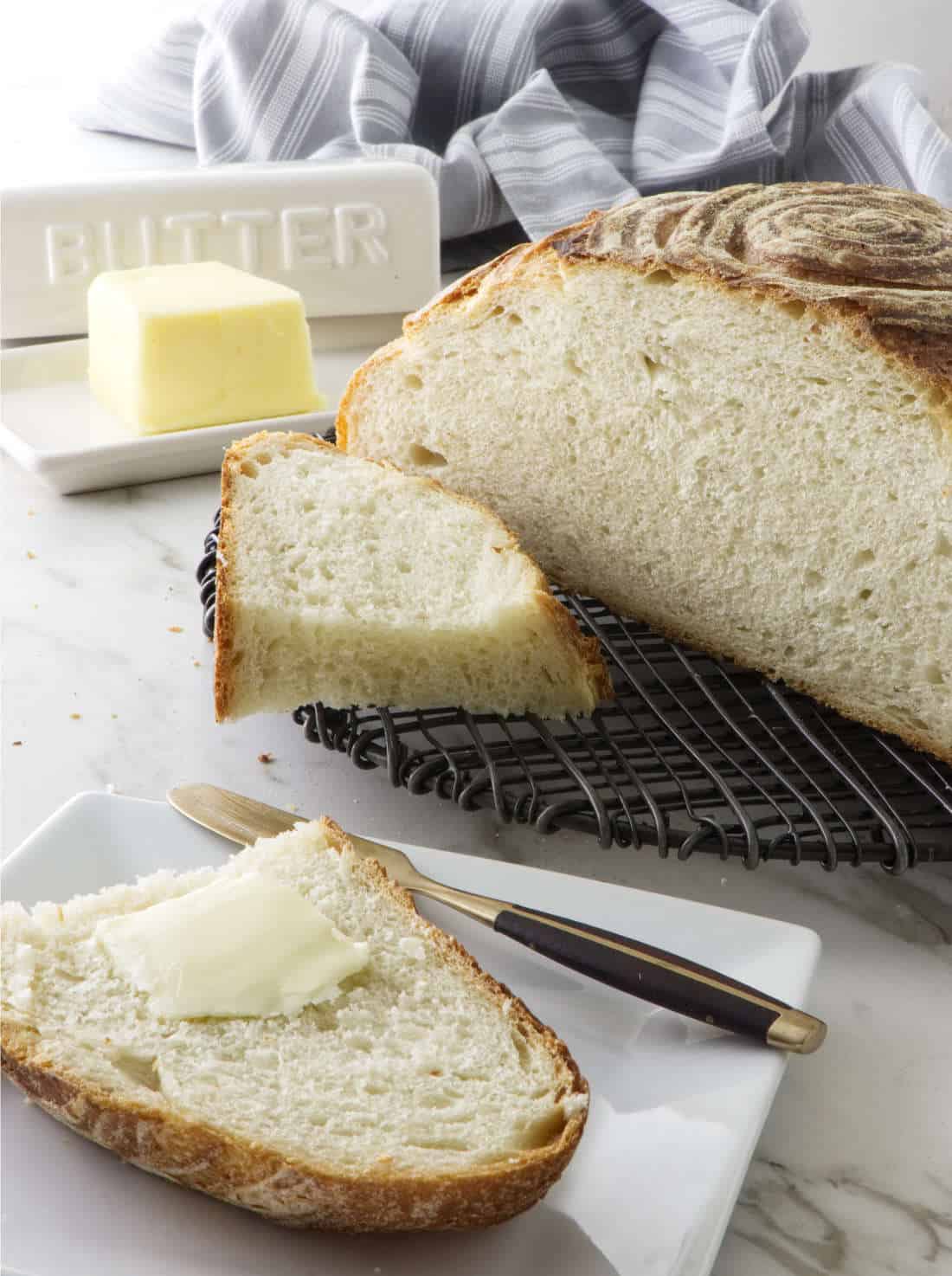
Adding salt to yeast bread
If you have ever made yeast bread and forgotten the salt, you will understand when I say it will need to be relegated to the compost bin. Perhaps you could use it to make seasoned croutons. But, honestly, bread made without salt is quite bland and tasteless.
Most yeast bread recipes will instruct you to add the salt just before the second rise. The reason many recipes have you add salt later is that salt will kill the yeast. With that said, this recipe (as with most yeast bread recipes) is only 2 percent salt. Truthfully, that is not enough salt to kill your yeast. So go ahead and add the salt in the beginning. The bread will rise just fine.
Shaping the dough
Since natural sourdough takes longer to rise, it can lose its shape over time. By placing it in a proofing basket or bowl, it will hold its shape and prevent the dough from spreading out and becoming flat. You can also help the dough hold its shape better by creating a tightly formed ball of dough. If you cup your hands around the ball of dough then drag it toward you, the dough will start to tighten. Turn the ball of dough and repeat that step three to four times and you will see that the surface tension improves. Watch our video to see how we shape the bread to increase surface tension.
What to use to hold the shape of the dough
There are several things you can use to hold the shape of your bread while it proofs. If you don’t have a proofing basket, a colander or pyrex bowl works well.
Using a colander
If you use a colander, place a tea towel in it so the dough does not fall through the holes. Flour the towel very well to prevent the dough from sticking to the towel. Plain flour will absorb moisture over time so we recommend using a mixture of rice flour and all-purpose flour. Make a blend with equal amounts of flour for perfect results.
Using a Brotform
If you want to use a bread proofing basket like this Brotform, you will not only end up with a nicely shaped loaf but the basket will leave a lovely impression on the dough. It makes a beautiful loaf of bread. As with the tea towel, you will need to give it a generous dusting of flour. Make a 50/50 blend of rice flour and all-purpose flour. If you only use all-purpose flour to dust the Brotform, the dough will stick to the Brotform when you try to remove it.
Using a mixing bowl
You can even use a mixing bowl to hold the shape of your dough. Just find a bowl the size and shape that you would like your bread to be shaped. It does not need to be an oven-proof bowl because you will not bake the bread in the bowl. Give the bowl a generous spray of oil and plop the dough into the bowl.
Once your bread has risen a second time you will tip it out of the bowl or basket and into a Dutch oven. If you don’t have a Dutch oven, you can tip it directly onto a baking sheet. You will get a nicer crust if you use a Dutch oven but you will still have great bread if you don’t use one.
More Sourdough Recipes
There are so many wonderful things to do with sourdough discard! Every time you refresh your starter, instead of throwing away the leftover unfed starter, you can put it to use in all kinds of delicious sourdough recipes.
- Sourdough Ricotta Pancakes
- Wild Yeast Sourdough Starter Recipe
- Sourdough Scones (with Discard)
- Sourdough Stuffing
- 17 Tantalizing Sourdough Recipes
Some other Bread Recipes you might like:
Watch our Video:
Check out our video and see how to make this easy sourdough bread recipe:
Pin this now to find it later!
Pin It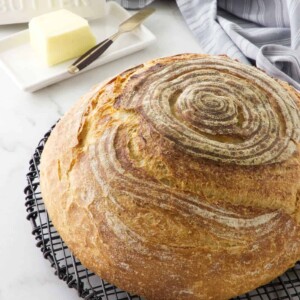
Easy Sourdough Bread Recipe
If you make this recipe, please leave a star rating and comment.
Ingredients
- ⅔ cup active sourdough starter, (160 grams)
- 1⅓ cups warm water, (314 grams)
- 4¼ cups all-purpose flour, (510 grams)
- 2 teaspoons salt, (12 grams)
Instructions
- Combine all the ingredients in the bowl and stir until it is a chunky, loosely combined dough.
- Dump the dough onto a work surface and knead the dough with your hands until the dough is smooth. (Essentially, you are massaging the dough by stretching and pushing. This will help develop the gluten.) At this stage, it will be wet and sticky. Don’t add more flour or your finished bread will be dense and heavy. The dough will stick to your hands and feel messy but if you get your hands wet it won't stick as easily.
- Place the dough into an oiled bowl. Cover the dough with plastic wrap or a towel and let it sit at room temperature for 3 to 6 hours (see notes) or in the refrigerator overnight. (A longer proof time in the fridge will give the bread a more tangy, sourdough flavor.)
- Turn the dough out onto a work surface and knock the air out of it then form it into a round ball. (See notes)
- Place the ball of dough into a proofing basket or any container that is the shape that you want your bread to be shaped. (See notes)
- Let the dough rise again a second time for 3 to 6 hours** at room temperature until doubled in size. (Or you could let it rise in the fridge overnight for 12 to 15 hours-see notes).
- Pre-heat the oven to 450°F. If you want to preheat your Dutch oven, place it in the oven for at least 30 minutes to heat up with the oven. It's an optional step but will give the bread some extra 'spring' (see notes).
- When the oven is hot, tip the loaf of bread into a dutch oven or onto a baking sheet. Make a slash in the loaf with a sharp knife. Bake for 45 to 50 minutes. If you are using a Dutch oven, remove the lid after 20 minutes.
Video
Notes
- The amount of time needed for your bread to rise will vary depending on the temperature and humidity. You can slow the rise by placing it in the refrigerator and speed the rise by placing it in a warm room or a dehydrator. A slower fermentation time will help develop more complex flavors.
- You will have more accurate measurements (and better results) if you weigh your ingredients with a scale.
- When you knead and shape your dough, try not to add any flour to your countertop. Adding additional flour will create a denser and heavier bread. You can prevent the dough from sticking to your hands by getting your hands wet.
- If you use a Brotform proofing basket or a tea towel in a bowl to shape your dough, give the basket or tea towel a very generous dusting of flour. Regular flour will absorb too much of the moisture and make the dough stick to the brotform. We recommend making a 50/50 blend of rice flour and all-purpose flour to dust your Brotform or tea towel.
- A Dutch oven works very nicely to form a crusty bread but if you don’t have one you can just bake the bread directly on a baking sheet or even on a hot pizza stone.
- If you let the dough ferment in the fridge, you may not see a significant rise. If the dough does not rise enough while in the fridge, let it sit out at room temperature to rise further before placing it in the oven.
Tips for baking in a Dutch Oven:
- Use parchment paper or spray the Dutch Oven with non-stick spray for easy removal.
- For an extra burst of steam and a slightly higher rise, preheat the Dutch Oven for 30 minutes before placing the bread inside. Use caution when you transfer the dough to the hot Dutch oven as it is easy to burn yourself.
- After the bread bakes for 30 minutes, remove the lid from the Dutch Oven and bake it the rest of the way without the lid.
Nutrition
Nutrition information is automatically calculated, so should only be used as an approximation.
 Like this recipe? Rate & comment below!
Like this recipe? Rate & comment below!John 6:35 Then Jesus declared, ‘I am the bread of life. Whoever comes to me will never go hungry, and whoever believes in me will never be thirsty’.
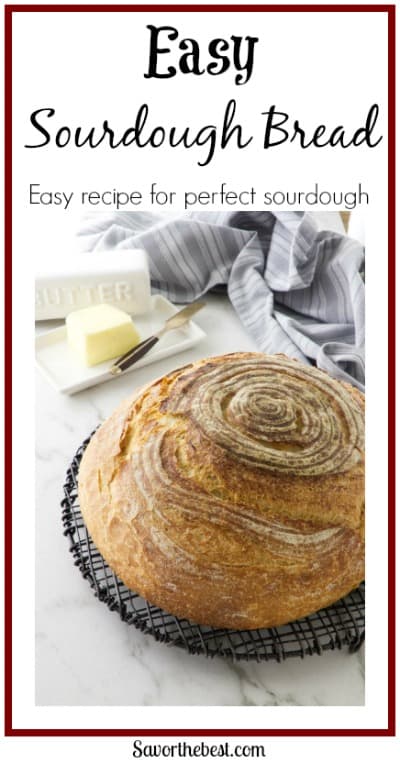

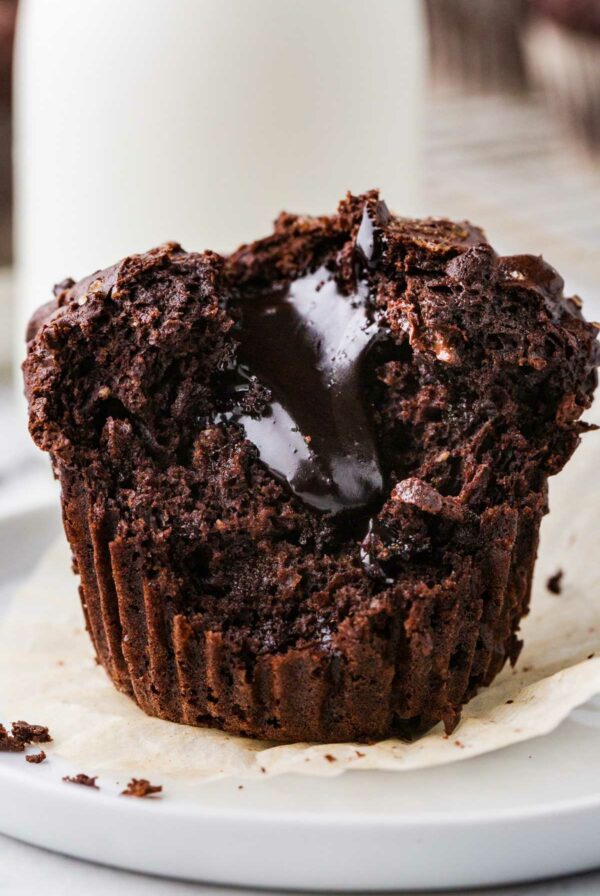

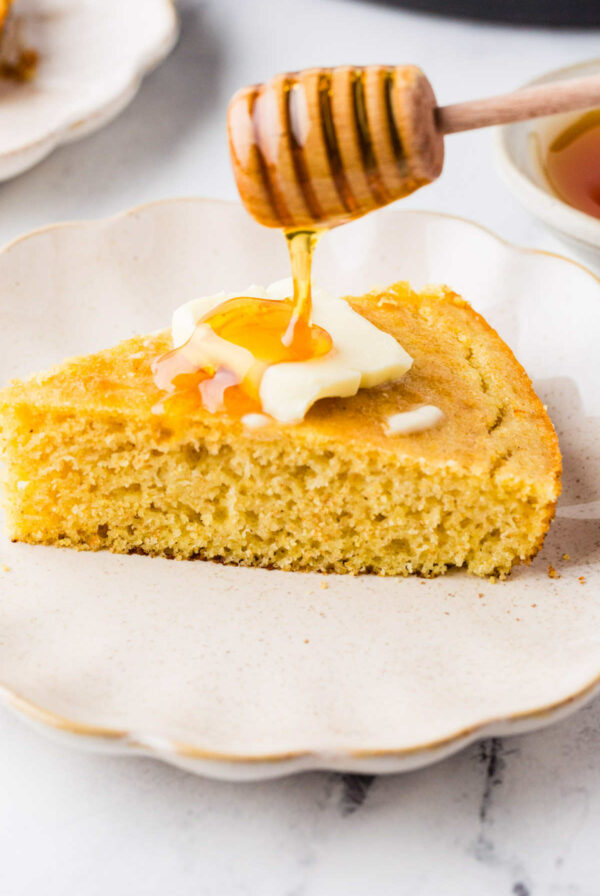
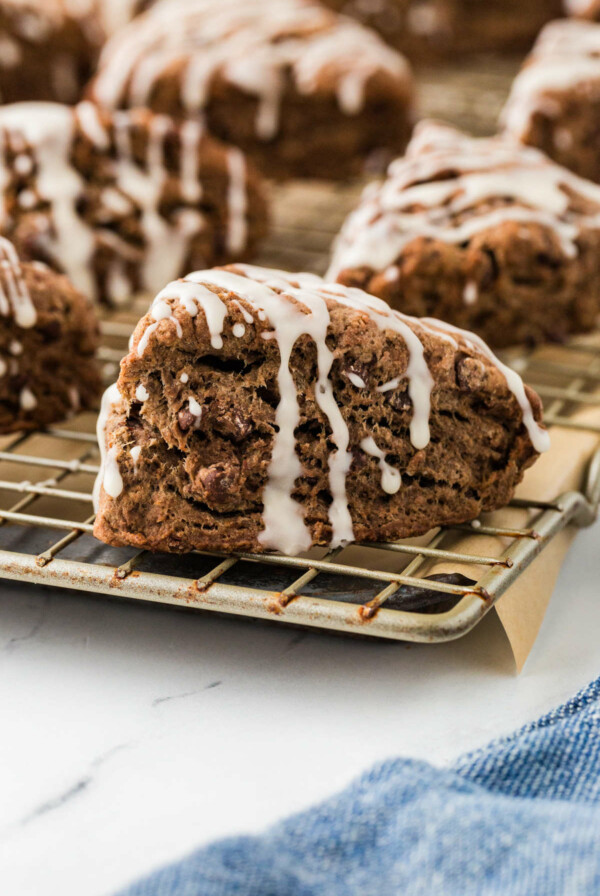










Made my first loaf. Can’t wait to eat it. Soooo excited
Awesome!! I’m excited for you!
I want to try this with the ancient grains GF flour blend. Will that flour blend allow a good GF sourdough bread recipe? I need to be rice free, so this blend is perfect for that. I already use the blend to feed my starter!
Gluten free yeast bread is a bit trickier to make. It can be done with the ancient grains flour blend but I haven’t developed a recipe for it yet.
Great recipe! At the risk of sounding dense, I just wanted to point out that it’s not obvious that you intend the Dutch oven to be preheated. I’ve only been making einkorn sourdough for about a year and I wondered why you didn’t preheat the Dutch oven for this recipe. I searched the comments and saw that you intended for the Dutch oven to be preheated but it’s not specific in the recipe itself (unless I’m missing something!) Maybe this is obvious to most 🤪. Thank you for the recipe! I’m going to make it again and I think it’s going to be my go to recipe! Your specificity concerning the starter hydration was so helpful! I didn’t even know what that meant and had to look it up!
Thank you for the comment, I appreciate all the help to make sure the recipe is clear. I did mention the option to preheat the DO in the notes but I added an additional step to make sure the notes don’t get missed. My intention was to make the step optional but I see how that was not easy to understand. You can make this bread without preheating the DO but you will get more oven spring if it is preheated. Please be careful with the hot Dutch oven. I hear so many stories of people burning themselves while transferring the dough to the pot. I hope the recipe is a little more clear now. Please let me know if I can clarify anything else.
This is the only recipe I use now. I have tried so many others and found them to be very time consuming.
Am I able to add cinnamon and raisins to the mix and still follow the same procedure?
Yes, you can add spices, nuts, seeds, dried fruit, sun-dried tomatoes, or olives to the dough. I like to soak my dried fruit to get it soft. If you do that, then keep in mind that it may affect the hydration of the dough, depending on how ‘wet’ the ingredients are. Just make sure any soaked fruit or ‘wet’ ingredients get patted dry. Thanks for the question and the compliment.
I have a cast iron Dutch Oven but it isn’t deep enough for a round loaf. You mention putting the loaf on a baking sheet or hot pizza stone. Both of which I have. My questions: Will either option change cooking time or temperature? Also would I have to put a pan of water in the oven or cover the loaf with foil?
The baking time is nearly the same if you bake the bread on a pizza stone or on a baking sheet instead of a Dutch oven. A Dutch oven will help the bread rise higher and have a springier texture. If you put a pan of water in the oven while you bake on a sheet pan, that will help a bit with oven spring. The bread won’t rise as high as it does in a Dutch oven but a bit of steam will help boost it a bit.
This is my go to recipe now. I have tried quite a lot and this has not failed me. I don’t like a dark crust on the bottom, so I place a round cooling rack on the bottom and place the dough and parchment paper on top of it. I now don’t get the “ burnt” crust. Also when I take the lid off, I set my timer for 5 minutes at a time I order to get a nice golden crust finish. I always let the dough sit I. A broth from basket overnight in the fridge.
Thanks for the comment. I’m glad the cooling rack helped get the bottom crust you like. Great trick.